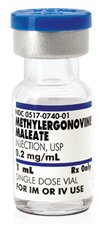Contact Us
By clicking Submit, you confirm that you accept our Privacy Policy and that you agree to your personal contact information being used to contact you and added to our database. If at any time you wish your personal information to be removed from the American Regent® database, please submit a message request to corpcommunications@americanregent.com.
CONTRAINDICATIONS
Hypertension; toxemia; pregnancy; and hypersensitivity.
WARNINGS
General
This drug should not be administered intravenously routinely because of the possibility of inducing sudden hypertensive and cerebrovascular accidents. If intravenous administration is considered essential as a lifesaving measure, methylergonovine maleate should be given slowly over a period of no less than 60 seconds with careful monitoring of blood pressure. Intra-arterial or periarterial injection should be strictly avoided.
Caution should be exercised in the presence of impaired hepatic or renal function.
Breast-feeding
Mothers should not breast-feed during treatment with methylergonovine maleate. Milk secreted during this period should be discarded. Mothers should wait at least 12 hours after administration of the last dose of methylergonovine maleate before initiating or resuming breast-feeding.
Coronary Artery Disease
Patients with coronary artery disease or risk factors for coronary artery disease may be more susceptible to developing myocardial ischemia and infarction associated with methylergonovine induced vasospasm.
Medication Errors
Inadvertent administration of methylergonovine maleate to newborn infants has been reported. In these cases of inadvertent neonatal exposure, symptoms such as respiratory depression, convulsions, cyanosis and oliguria have been reported. Usual treatment is symptomatic. However, in severe cases, respiratory and cardiovascular support is required.
Methylergonovine maleate has been administered instead of vitamin K and Hepatitis B vaccine, medications which are routinely administered to the newborn. Due to the potential for accidental neonatal exposure, methylergonovine maleate injection should be stored separately from medications intended for neonatal administration.
PRECAUTIONS
General
Caution should be exercised in the presence of sepsis or obliterative vascular disease. Also use with caution during the second stage of labor. The necessity for manual removal of a retained placenta should occur only rarely with proper technique and adequate allowance of time for its spontaneous separation.
Drug Interactions
CYP3A4 Inhibitors - There have been rare reports of serious adverse events in connection with the coadministration of certain ergot alkaloid drugs and potent CYP3A4 inhibitors, resulting in vasospasm leading to cerebral ischemia and/or ischemia of the extremities. Although there have been no reports of such interactions with methylergonovine alone, potent CYP3A4 inhibitors should not be coadministered with methylergonovine.
CYP3A4 Inducers - Drugs that are strong inducers of CYP3A4 are likely to decrease the pharmacological action of methylergonovine maleate.
Beta-blockers - Caution should be exercised when methylergonovine maleate is used concurrently with beta-blockers. Concomitant administration with beta-blockers may enhance the vasoconstrictive action of ergot alkaloids.
Anesthetics - Anesthetics like halothane and methoxyflurane may reduce the oxytocic potency of methylergonovine maleate.
Glyceryl trinitrate and other antianginal drugs - Methylergonovine maleate produces vasoconstriction and can be expected to reduce the effect of glyceryl trinitrate and other antianginal drugs.
Caution should be exercised when methylergonovine maleate is used concurrently with other vasoconstrictors, ergot alkaloids, or prostaglandins.
Pregnancy
Category C. It is not known whether methylergonovine maleate can cause fetal harm or can affect reproductive capacity. Use of methylergonovine maleate is contraindicated during pregnancy because of its uterotonic effects.
Labor and Delivery
The uterotonic effect of methylergonovine maleate is utilized after delivery to assist involution and decrease hemorrhage, shortening the third stage of labor.
Nursing Mothers
Mothers should not breast-feed during treatment with methylergonovine maleate and for at least 12 hours after administration of the last dose.
Pediatric Use
Safety and effectiveness in pediatric patients have not been established.
Geriatric Use
In general, dose selection for an elderly patient should be cautious, usually starting at the low end of the dosing range, reflecting the greater frequency of decreased hepatic, renal, or cardiac function, and of concomitant disease or other drug therapy.
ADVERSE REACTIONS
The most common adverse reaction is hypertension associated in several cases with seizure and/or headache. Hypotension has also been reported. Abdominal pain (caused by uterine contractions), nausea and vomiting have occurred occasionally. Rarely observed reactions have included: acute myocardial infarction, transient chest pains, vasoconstriction, vasospasm, coronary arterial spasm, bradycardia, tachycardia, dyspnea, hematuria, thrombophlebitis, water intoxication, hallucinations, leg cramps, dizziness, tinnitus, nasal congestion, diarrhea, diaphoresis, palpitation, rash, and foul taste.
There have been rare isolated reports of anaphylaxis, without a proven causal relationship to the drug product.
Postmarketing Experience
Because these reactions are reported voluntarily from a population of uncertain size, it is not possible to reliably estimate their frequency. Cerebrovascular accident, paraesthesia, ventricular fibrillation, ventricular tachycardia, angina pectoris, atrioventricular block have been reported.
OVERDOSAGE
Symptoms of acute overdose may include: nausea, vomiting, oliguria, abdominal pain, numbness, tingling of the extremities, rise in blood pressure, in severe cases followed by hypotension, respiratory depression, hypothermia, convulsions, and coma.
Because reports of overdosage with methylergonovine maleate are infrequent, the lethal dose in humans has not been established.
INDICATIONS AND USAGE
Following delivery of the placenta, for routine management of uterine atony, hemorrhage and subinvolution of the uterus. For control of uterine hemorrhage in the second stage of labor following delivery of the anterior shoulder.
For additional Safety Information, please see Full Prescribing Information.
You are encouraged to report adverse drug events to American Regent, Inc. at 1-800-734-9236 or to the FDA by visiting www.fda.gov/medwatch or calling 1-800-FDA-1088.
REF-0638 6/2020
